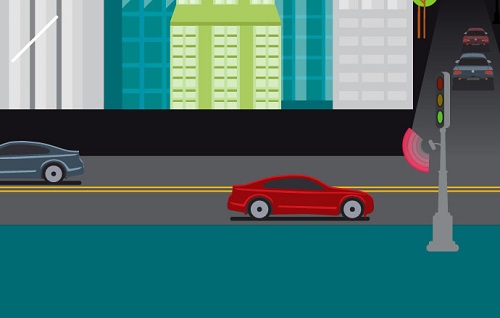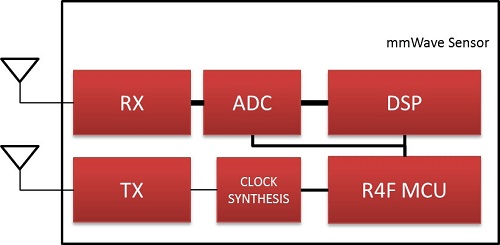BY KEEGAN GARCIA,
Marketing Manager for Radar and Analytics Processors
Texas Instruments
www.ti.com
Transportation systems are critical to moving individuals and freight quickly, efficiently, and safely around the world. So transportation systems and the associated infrastructure must respond to long-term and real-time changes by collecting data and sensing conditions around the trafficked areas. Traffic engineers use the data to build statistics and help target future infrastructure investments while drivers use the data to help manage their routes.
With the intelligent transportation systems market forecasted to reach more than $63.6 billion by 2022, the value of this information is obvious. However, while traffic-monitoring systems offer the ability to increase transportation efficiency and safety in a variety of conditions, designers face a variety of sensing challenges, including:
- Position and velocity measurement: In order to be useful, traffic data needs to provide knowledge of both traffic location (position) and flow (velocity). It might include distance from the stop bar at an intersection or the approaching vehicle speed.
- All-weather operation: Because traffic infrastructure sensors tend to be located outdoors, they must be able to work no matter what the weather is. It includes both day and night light scenarios as well as consistent functionality in inclement weather like rain, snow, fog, and dust.
- High-speed object detection over extended ranges: Sensors must be able to detect and measure faster-moving traffic at longer distances. For example, if a system is able to sense vehicles farther away from an intersection, it can better control green and yellow durations to anticipate incoming traffic.
- Accuracy and performance measurement: Accurately understanding vehicle lane location, vehicle distance from the sensor, and vehicle speed are critical for the effective operation of traffic-monitoring infrastructure.
Today’s traffic-monitoring technology
There are a variety of sensing technologies in use today for traffic-monitoring applications. They serve different market functions, and each comes with a unique set of pros and cons:
- Inductive loop sensors: In these solutions, an insulated and electrically conductive wire is passed through cuts in the roadway. An electrical pulse is run through this wire, and the change in inductance as a result of a car passing over indicates when a vehicle occupies a space or passes by. Although common and well-understood, inductive loop sensing has several shortcomings.
First, detection is limited to a “presence” around wherever the loop is installed, so the anticipation of oncoming traffic is difficult. Second, the scale of the system requires that each zone and lane have its own loop at an intersection, making it a costly and complex system to implement.
But perhaps the biggest downside is that installing or repairing these systems requires digging up the road surface. Combine that with the often-short maintenance cycles (one to two years) of these systems, and the overall cost of an inductive loop system compounds quickly.
- Cameras and vision-based sensors: Using a video image processor, cameras and vision-based sensors capture image data from a CMOS camera sensor. Next, this imagery is analyzed to determine traffic behavior.
These systems can be powerful tools to not only measure traffic behavior at intersections and highways but also to transmit live video to operators.
However, changing environmental conditions — day and night cycles, shadows, and poor weather — directly impact the ability of these systems to “see.” Moreover, these vision challenges mandate advanced signal processing and algorithms, and that significantly increases the system complexity.
mmWave radar-based traffic monitoring
One technology that’s getting traction in the traffic-monitoring market is radar, particularly the solutions based on millimeter-wave (mmWave) technology. mmWave’s unique advantages — including insensitivity to light or weather, extended range compared to vision-based technologies, and improved accuracy — perform very well in traffic-monitoring applications (Fig. 1 ).

Fig. 1: The mmWave sensors are usually mounted on a traffic pole and are not impacted by road conditions.
So when it comes to sensing challenges that traffic management systems face, mmWave radars can improve transportation efficiency and safety in a variety of ways.
- Operation in all-weather conditions: Those familiar with radar applications and RF signal propagation likely know that radar is insensitive to changing environmental conditions. However, mmWave has the ability to penetrate and sense through adverse weather conditions such as night time, smoke, fog, and rain (Fig. 2 ). And this capability makes mmWave sensors a robust and consistent solution for outdoor sensing in uncontrolled and variable environments.

Fig. 2: The mmWave sensors can detect vehicles at extended ranges regardless of weather conditions.
- Detection of high-speed objects over extended ranges: The mmWave sensors use fast frequency-modulated continuous wave (FMCW) radar in the 77-GHz range, which has several advantages over legacy radar systems. The combination of antenna design and RF chirp configuration allows the 77-GHz radar system to easily detect targets, including vehicles, at ranges of 150 m or more and velocities beyond 100 km/h.
- Accuracy of object measurement: Fast FMCW radar with integrated processing is capable of measuring the range, radial velocity, and angle of many target reflectors in a scene multiple times in a second. It allows traffic-monitoring systems using mmWave solutions to easily identify and track multiple vehicles in real time with a high degree of range and velocity resolution.
Overcoming radar design challenges
There are certain challenges to implementing a radar solution, however. Today’s radar solutions require multiple discrete components to create a complete solution. That includes an RF front end and a digital processing back end (Fig. 3 ).

Fig. 3: A view of a discrete mmWave radar design that uses separate chips for RF front end and digital processing back end.
A discrete radar system requires a central controller like an MCU to route control signals to all discrete components. And that potentially creates electromagnetic interference (EMI) effects, which eventually leads to “noisy” systems.
This lack of integration increases design complexity and comes at the expense of system size, cost, and power consumption. Moreover, discrete radar systems create software challenges amid changing conditions and application needs.
The newer mmWave solutions operating in the 76-GHz to 81-GHz frequency band overcome these shortcomings by integrating DSPs with powerful MCUs based on ARM cores (Fig. 4 ). The single-chip solutions eliminate the need for high-speed data transmission between discrete front-end, analog-to-digital converter, and processing parts.

Fig. 4: A single-chip solution simplifies hardware and software design of a mmWave radar sensor.
The processing chain is implemented exclusively on the DSP while the ARM processor is made available for additional higher-level processing and management functions such as tracking logic, object classification, traffic statistics reporting, I/O functions, and sensors management.
It’s worth noting that object detection and tracking are critical steps in understanding and analyzing the traffic environment. And the single-chip solutions can accommodate the advanced algorithms that provide real-time intelligence to detect, track, and classify objects.
The DSP performs the object clustering and tracking algorithms to process data on how vehicles are moving and then the MCU can react to dynamic traffic intelligently and in real time. The single-chip solutions also facilitate small form-factor applications, which, in turn, accurately measure the range, velocity, and angle of objects in view.
Conclusion
The unique features and capabilities of mmWave sensors enable high-performance detection and analysis at the sensor edge and make them an exceptional fit for smart traffic-monitoring applications. And single-chip solutions lower the barrier of entry to mmWave sensing designs.
Advertisement
Learn more about Texas Instruments





